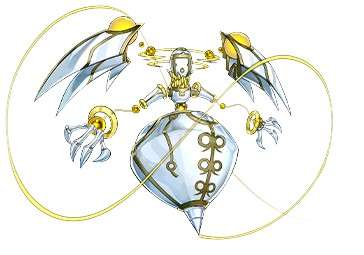Introduction to Sacred Beasts Part 1
Many fans know about the ‘Egyptian God’ cards from the ‘Yugioh Duel Monsters’ anime series. But they aren’t the only set of three almighty beings. In ‘Yugioh GX’, we were introduced to their counterparts; the three ‘Phantasms’, or in English, the ‘Sacred Beasts’. These are more deadly versions of the ‘Egyptian Gods’. Their names are “Raviel, Lord of Phantasms”, “Hamon, Lord of Striking Thunder” and “Uria, Lord of Searing Flames”. In addition, they had a powerful combination of the three called “Armityle the Chaos Phantasm”.
Over the years, the ‘Sacred Beasts’ received a few support cards; not many, but more than the ‘Egyptian Gods’ did, making them comparatively better cards. However, despite the occasional support, they weren’t entirely playable. Hamon occasionally made appearances in certain ‘Crystal Beast’ decks due to an interesting synergy. Or a Trap Monster deck featuring Uria but otherwise ‘Sacred Beast’ wasn’t an entire deck by itself. Not with only a few support cards, at least.
That is until recently. After being defeated by ‘Shaddolls’ by only one percent in an OCG Structure Deck poll, they were given a Structure Deck of their own. This gave them a new set of support, turning them into a playable deck. In July 2020, the Structure Deck comes out in the TCG for players to experience. This two part article serves to give an introduction to the ‘Sacred Beast’ support cards and what they do, so you can get started on building a deck around them. The first part will mostly go over the existing Sacred Beast cards that we had prior to the support, with the second part going over a bunch of new cards for the strategy.
While you can make decks focusing on an individual ‘Sacred Beast’ or two, this article will mostly be about how decks containing all of them will function with these new cards. However, those other decks may still have some brief mentions. It’s important to know roughly what kind of things you can do with them. Now the deck is by no means competitive or anything for high level play, but it’s far more playable than it used to be. Because of that, it’s a fun option to have a go with.
There’s also a very fun combo you can do with them that we will go over. It does use “Predaplant Verte Anaconda” which isn’t entirely budget-friendly, so bare that in mind.
Before, we move onto the new support, let’s take a look at the original ‘Sacred Beasts’ and their support, before we go over the cards introduced in the Structure Deck.
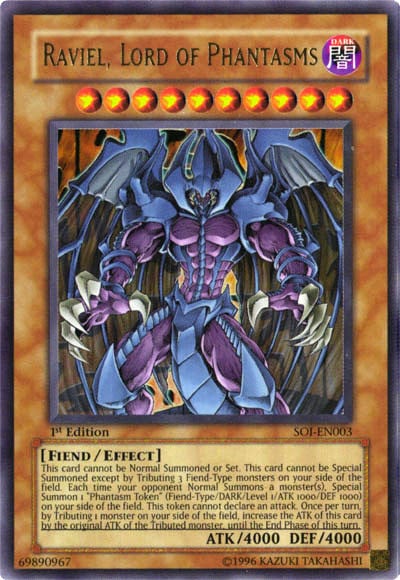
Raviel, Lord of Phantasms
This sinister version of “Obelisk the Tormentor”, is a big Fiend Type with 4000 Attack and Defense, making it one of our big bodies on the field. Unlike the ‘Egyptian Gods’, who require a Normal Summon of three tributes, this guy gets a Special Summon of three tributes. However, in Raviel’s case, they have to all be Fiends too. If your opponent Normal Summons, you get to summon a little “Phantasm Token” with 1000 Attack, which you’d ideally tribute for Raviel’s other effect of gaining Attack equal to the Tributed Monster.
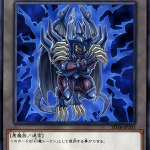
Other than getting to very high levels of power, Raviel was the least usable of the Sacred Beast cards originally, due to requiring three Monsters on the field to tribute for it. The other two had less steep requirements, which will be discussed shortly. Certain later support does make getting it out easier, and it’s a great choice for when “Dark Summoning Beast” and the like.
Other options for Tribute material included “Phantom Skyblaster” which got out at least once Token when you summon it, which made good tribute fodder for Raviel, though that is now Limited. As for Raviel’s effects, having a Token generation can be useful for a Link Summon or something, but otherwise it was a just a Monster for having big power and lacked any protection of its own, so not the most competitive option. In tandem with the support, it will be better though. They have their own Field Spell, that will be discussed shortly, that provides that needed protection. Also, the new Structure Deck provides a means of using Raviel for an OTK strategy alternative to the deck’s Armityle OTK.
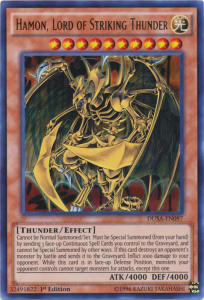
Hamon, Lord of Striking Thunder
Another big guy with 4000 Attack and Defense, “Hamon Lord of Striking Thunder” is not summoned by using monsters as Tribute, but rather three Continuous Spell cards. There wasn’t much in the way of good Continuous Spells for it in the game for a long time, especially ones that really gelled with Hamon’s strategy. “Prohibition” was an option, but it wasn’t an amazing one. The ‘Crystal Beast’ archetype would often turn their Monsters into Continuous Spells that could then be used as tribute, allowing Hamon to be a good beat-stick in their strategy as well using one of its effects to protect other monsters, but not necessarily a must-have in that deck either. Due to having 4000 Attack like Raviel does, it’s also a good option for “Dark Summoning Beast” too.
Hamon’s effects included some burn damage when attacking, which maybe helped push forward with the OTK, but otherwise not impressive. Then in Defense position, it protected other cards from attacks which is an alright effect. With the newer support that will be explored soon, it finally gets two very helpful Continuous Spells that help get it out more reliably including one that puts it into Defense position to take advantage of the attack protection effect more readily. Because of this, Hamon is probably the most useful ‘Sacred Beast’ to have out on the field now from a utility perspective. If you fill out your field with one, as well as their Field Spell and a new Continuous Trap card that is a floodgate sometimes, you can build a nice defensive field.
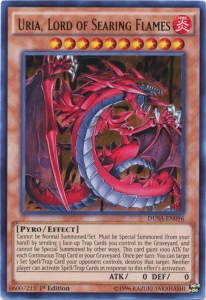
Uria, Lord of Searing Flames
“Uria, Lord of Searing Flames” is the third member of the ‘Sacred Beasts’ and unlike the other two; it doesn’t have those big stats on it right away. Rather it starts with zero. It’s Special Summoned by using three Face-Up Trap Cards as Tribute, usually Continuous Traps. Then it gains 1000 Attack for each Continuous Trap in the Graveyard. So it’s usually starting with 3000 from that, but it can go up to higher amounts the more Traps go to the Graveyard. Uria is therefore can be less reliable as a big monster than the others. However, it can also destroy an opponent’s Spell or Trap once per turn, which can’t be responded to by Spell or Traps. A bit of removal in this deck is quite welcome, as the ‘Sacred Beast’ deck lacks a lot of disruption options on its own.
You won’t be able to summon Uria as often via the support that provides other methods of summoning it, because then it will start with only zero a lot of the time, unless you have means to give it more Attack. Its signature Continuous Trap in the new Structure Deck does assist with that somewhat, with letting Traps on the field also count.
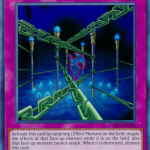
Uria usually benefits from its own dedicated builds, with Trap Monsters or something like that with a heavy Trap line-up. There are also disruption cards like “Fiendish Chain” which work out very well, acting as both a way to make sure your combos keep going and getting out Uria. This means those cards become multi-functional.
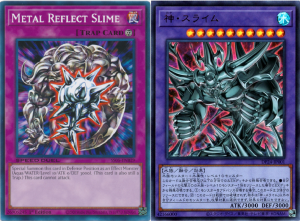
“Metal Reflect Slime” is a good Level 10 Trap Monster as it has a big Defense value. In addition, when “Egyptian God Slime” comes out in the TCG, you could also tribute the “Metal Reflect Slime” for that and get another 3000 body on the field that is also a Level 10, a level with utility in this deck.
When it comes to all-purpose ‘Sacred Beasts’ decks, outside of dedicated builds, Uria lags behind as you’d often run less Traps than other kinds of cards due to their inherent slowness. ‘Sacred Beast’ decks like to go second, but Traps are usually good for going first. For that reason, while I’d suggest running two copies of Raviel and Hamon each, Uria could be at just one. Though you could still run two if you have the room. It helps to have the Beasts available in order to get your combos through, so having the second as a backup is still worth it.
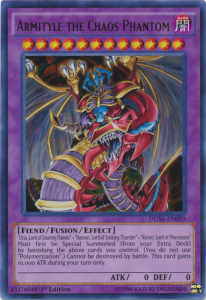
Armityle, the Chaos Phantasm and Phantasm Emperor Trilojig
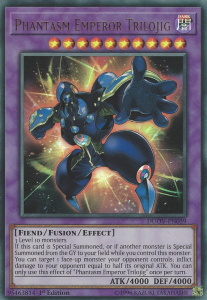
These are the big Fusion bosses, the Fusions of the Sacred Beasts. Armityle is a dark counterpart to “The Creator God of Light, Horakhty”. Trilojig was a card in the 'Yugioh Arc-V' Manga, along with other references to legendary monsters.
Armityle starts at only 0 Attack but during your turn, he jumps up to Ten Thousand Attack, a very strong boost all at once. However, during the opponent’s turn, he goes back to zero. So unless you were able to pull off an OTK right there, Armityle would get run over and while he had battle protection, you’d take a bunch of damage still. That’s sort of a waste of all the effort to summon him, since he required all three of the ‘Sacred Beasts’ as material. If you had all three at once on the field somehow, that would have been better than using them as material. With the release of the Structure Deck, Armityle's name is no longer "Armityle the Chaos Phantom", but rather 'Phantasm' to fit better with the other cards.
The other boss is Phantasm Emperor Trilojig, a relatively newer card. 4000 Attack and Defense and an okay burn effect to push for the win, but otherwise not too impressive. However, he’s a more reliable body on the field than Armityle, as he consistently has 4000 instead of going down 0. For that reason, if you have to go first in a duel, Trilojig is the better thing to end on, whereas Armityle is better for going second.
The newer support introduced in the Structure Decks makes getting these guys out far more viable and less of a gimmick because they finally can more reasonably summon these guys and get that win condition. While unlike Trilojig, Armityle didn’t require a specific Spell card to make it, it gets one that works out better for bringing out either of them.
We’ll talk about that shortly and revisit how Armityle and Trilojig fit in. But let’s look at the last pieces of pre-Structure Deck cards for this archetype first. Since they are playable now, it’s worth running 1-2 of each of them in your Extra Deck. Keep in mind, that this deck lacks protection from disruption. While there are new combos to summon something like Armityle, the opponent may have many ways to deal with it.
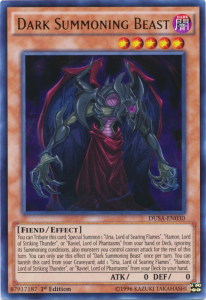
Dark Summoning Beast
“Dark Summoning Beast” was made to be a more reliable way of bringing out the ‘Sacred Beasts’, without having to do so many Tributes. You simply Tribute this guy by himself and you could Special Summon a ‘Sacred Beast’ right away. Not only that, but doing this could let you summon them from the hand or deck. Although, Uria may have only 0 Attack by this method if you didn’t already have Traps in the Graveyard. Unfortunately, while necessary in a ‘Sacred Beast’ deck, “Dark Summoning Beast” has two pretty major drawbacks.
Firstly, it is Level 5, so you still needed to Tribute something else to get it out. You could try to use the Continuous Trap “Sinister Yorishiro” to get it out without Tribute. But that’s not the most consistent strategy.
Secondly, activating this effect stopped you from attacking during that turn, which meant getting that OTK was impossible. That gave your opponent a big chance to break your board when their turn comes around. A new support card in the Structure Deck does fix the first problem by giving another Normal Summon. But the second is still a potential game-ender. You need to run 2-3 of them, as you need as many avenues of bringing out the Beasts as you can. The Structure Deck provides a counterpart ‘Summoning Beast’ that doesn’t have these downsides. But it doesn’t have the part about summoning from the deck, which means the original is still worth running.
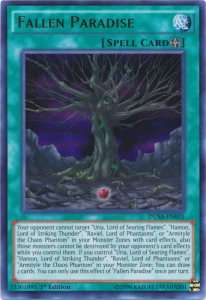
Fallen Paradise
This is what we call very good legacy support for an archetype/series. “Fallen Paradise” is the reason why even before the new Structure Deck, the ‘Sacred Beasts had potential’. This card is fantastic. Run three, plus “Terraforming” and maybe even “Metaverse” too. It gives the ‘Sacred Beasts’, plus Armityle, protection from targeting and destruction. This fixes the major problem with those cards. You put in a lot of effort to bring out a big card, only to lose it right away to removal.
“Fallen Paradise” also fixes some of the consistency issues for a deck like this. If you control one of the ‘Sacred Beasts’ or Armityle, you get to draw two cards once per turn. A “Pot of Greed” once every turn. That’s pretty nuts. If it was in a more competitive archetype, it would have been banned, but it’s only in this one. Still, it’s a super fun thing to have and getting those draws are great. It doesn’t matter what build you run, you have to max out on this. The new Structure Deck also gives another means of searching it.
The Structure Deck Approaches! Introduction Part 2
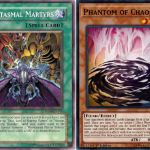
and Phantom of Chaos
We’ve finally gone over the cards that existed before the Structure Deck. For a long time, we had the original three ‘Sacred Beasts’, along with Armityle, “Dark Summoning Beast” and “Fallen Paradise”. There was also “Phantasmal Martyrs”, which summon some Tokens; this card was not good, so we don’t need to talk about it more. You also had “Phantom of Chaos” which could pretend to be a ‘Sacred Beast’ in your Graveyard; in order to get out Armityle, you could run one if you’d like to give it a whirl. But it’s not the greatest option anymore.
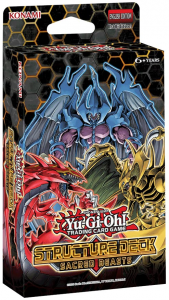
Then we got Trilojig, which was neat, but not a huge addition to make this deck playable. Thinking about playing all three together in a deck and even considering Armityle as an option, was a pipe dream. But then, we got the poll and there was hope. Now, we’ve got the new Structure Deck and it’s time to start talking about what we got in it. Up until this point, we’ve left things in quite vague. But now that will change.
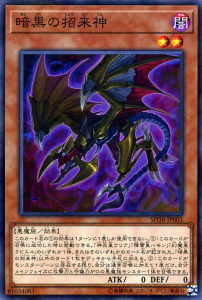
Dark Beckoning Beast
This is the one that changed things a lot. Our starter card. The card you want to open to get things going, so naturally, you’d play three. “Dark Beckoning Beast” is the way to get to pretty much anything we need from the deck. Once per turn, when Normal Summoned, you can add one of the ‘Sacred Beasts’ or a card that lists them from your deck to your hand. Pretty much all of the support lists them, so having this guy gives you access to most of the deck. It’s also a big part of the main Armityle combo.
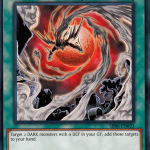
That’s not all. Its second effect gives you an extra Normal Summon that turn. Primarily, a summon of a Fiend-Type with 0 Attack and Defense. Considering the main support monsters in this deck fit those categories, the restriction is no big deal. Monsters with those stats also make good targets for cards such as “Recurring Nightmare” and “Dark Eruption”.
You’ve got a lot of options with this card. You could bring out another monster and go into a Link-2 perhaps? You want to gather Fiends for Raviel’s summon? Or you can use that extra Normal Summon to fix the problem with “Dark Summoning Beast. You could then tribute “Dark Beckoning Beast” for it the same turn. A good search option is the next card we’ll talk about.
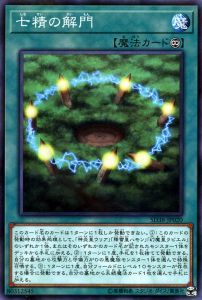
Opening of the Spirit Gates
This is the other play-starting card. When activated, you can search a ‘Sacred Beast’ or a monster that lists their names. This one only searches monsters, not Spells and Traps. What’s more, this is a Continuous Spell, staying on the field after activation. That means finally we are getting good options for things to tribute for Hamon, something sorely needed.
This card also gives some needed revival, which will also help in the main combo. You can discard a card to bring one of your 0 Attack and Defense Fiends back from the Graveyard. If you control a Level 10, you can bring another Continuous Spell from your Graveyard back to your hand. Everything this card does is a once per turn effect. This card gives you a searcher and a recycler, making it fantastic throughout the entire time of the duel. Run three of them.
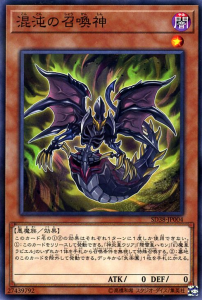
Chaos Summoning Beast
“Chaos Summoning Beast” is another Fiend-Type with 0 Attack and Defense, meaning it’s a target for your searchers. It’s also an alternative option to “Dark Summoning Beast”. What makes this one better is its level 1 status, so you don’t need to Tribute something to summon it. Secondly, it doesn’t have that attack restriction that gets in the way. You Tribute “Chaos Summoning Beast” and you Special Summon one of the Sacred Beasts to the field, just like that. However, they have to be in your hand, not in your deck, like “Dark Summoning Beast” allowed. You want to run three of these as well.
That’s not all. You can Banish this guy from the Graveyard and search “Fallen Paradise” from your deck. That means, this card not only gets a Sacred Beast out, but also provides their protection right away. “Chaos Summoning Beast” is a good card to discard too, due to providing this search effect.
Part 2 Coming Shortly
That's all we can show you for Part 1 so far, but we've only just begun. We've teased you with the first three new Structure Deck cards. This being our important starter cards; both of which you'll love to open. As well as our new 'Summoning Beast' to make getting out our main monsters easier than ever. Check out Part 2 to see the other cards from the Structure Deck!
